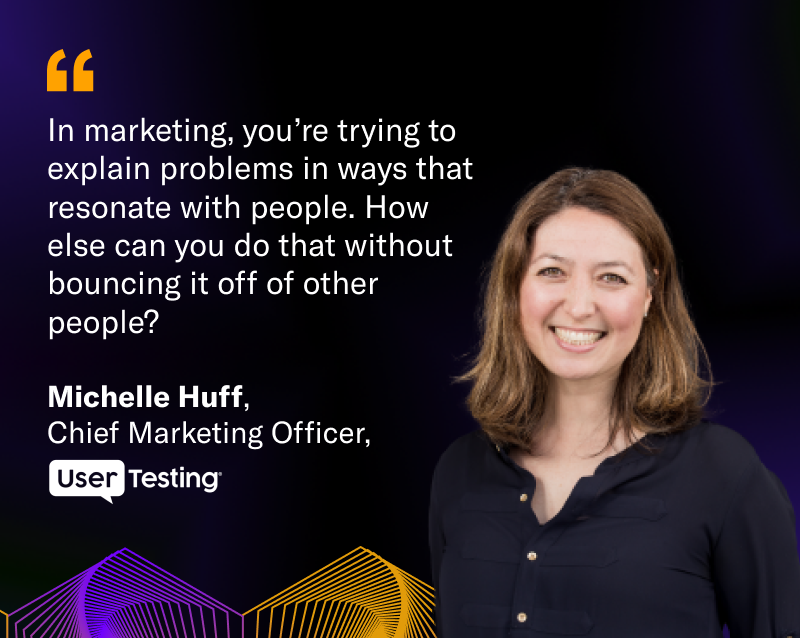Managing the Go-To-Market Strategy for a Global Company: Meet Michelle Huff from UserTesting

Maximize Your Marketing ROI
Join 10,000 other marketers already getting the best tips on running engaging events that boost pipeline and create raving fans.
In the 15th episode of our CMO Diaries series, Kishore sat down with Michelle Huff, Chief Marketing Officer at UserTesting.
UserTesting is a video-first platform where you can see and hear the experiences of real people as they engage with your products, designs, apps, processes, concepts, or brands. As the first human insight platform, UserTesting empowers everyone in an organization to create exceptional experiences.
Michelle joined Kishore to chat about UserTesting’s go-to-market strategy, how her team manages marketing across broad segments from SMB to enterprise, and much, much more. This is a can’t-miss episode for anyone interested in enterprise B2B marketing!

Welcome to CMO Diaries! Tell us more about your background and why you’re excited about the company right now.
Thanks for having me! I’m currently the Chief Marketing Officer at UserTesting, and I’ve been with the company for about three and a half years now.
I’ve worked in tech for over 20 years, but one of the reasons why I really love UserTesting is because it’s a feel good product. At the end of the day, we help people get into the shoes of customers and prospects and see things from their perspective. Whether you’re building a digital experience, you’re writing marketing copy, or you’re coming up with an offer—there’s often these moments when you think, “I wonder what other people think about it.”

People use UserTesting for product, design, marketing, customer experience, and many different roles. We talk a lot about empathy at UserTesting. We wholeheartedly believe in kindness and that it’s important to understand things from diverse perspectives—not just your team or yourself, but many others.
In that sense, it’s a good space to be in. It’s growing. I say it’s “feel good” because that alone— having a company that talks about empathy and having people internally live those values feels good. It’s been a cool culture to be a part of.
How does the Go-To-Market motion work across different audiences and use cases?
It’s a blessing and a curse that any company that has a customer can be a customer of UserTesting. Our product has a very broad applicability. So many roles, departments, industries, and company sizes can really benefit from it.
We are more of an enterprise selling B2B software. We have every segment—SMB, mid-market, enterprise, and global (which are our named accounts).
We also have a global component in Europe, Asia Pacific, and North America. It is a model where I’ve built out the teams, especially demand generation, that have alignment to different segments.
We have more traditional demand generating programs as well as account based marketing. When you sell into enterprise we have larger deal sizes and the marketing mix changes.
We also have other components around field marketing and events to support that.
How does marketing change from SMB to enterprise?
Well, I’ve got my philosophy.
How I see it is that, when you are enterprise sales-led, you are often trying to reach a really high level decision maker.
Imagine trying to close a million dollar deal. Usually, you’re not just selling to one person. They might have the budget to do it, but normally you have to get buy-in across a lot of people.
You end up with a dynamic where you have an enterprise selling team that’s very consultative. They go in, talk about business transformation, and are a thought partner to the decision maker. The company doesn’t think of you as a tool. You are in a much more consultative mode.
For the marketing mix, if we’re trying to help scale that approach, there’s account based marketing. The content becomes interesting—how we do blogs and the types of content we’re producing changes. We have more high-touch events. Events give us a chance to build these relationships that are so important in enterprise deals. There’s also customer and engagement programs put in place for enterprise specifically.
For SMB, the challenge is that the more down market you go, the broader the number of accounts and customers you have. It almost starts to feel more B2C.
The reason SMB is often more profitable (at the beginning) is because you can spend a lot on enterprise selling; the cost of sales and marketing can be quite high. But, you have a lot more efficiencies in SMB.
For us, we have a lot more digital components in SMB. And, this is where product-led growth comes in—putting people through digital buying journeys. The mix changes. The scale changes. You’re trying to bring people to that buying point as quickly as possible so the sales team can close deals.
You mentioned using content for education. Does content add value to the pipeline? How do you think about content?
What’s interesting is, we’ve been doing a lot more over the past year and then catching up with the data. So, we’ll have more insights later this year on which content is more influential from a digital standpoint.
The way I think about it is, in a perfect world, everyone would love to have a one-on-one conversation with the best company representative. If they were incredibly helpful and drove you to make great decisions, you’d have an overall great experience.
If you turn all of that into digital experiences, it’s self-serve. People will think, “oh, this is great, and I didn’t have to talk to anyone.” So, how do we know what to turn into content? Well, the sales team will share objections they’re facing or specific things people are having a hard time understanding. They’ll tell us what they’re hearing directly from customers and prospects, and we’ll turn around and turn that into content.
Marketing can also help these teams scale. Instead of having all of these separate conversations, we turn those conversations into content pieces. We now see a lot of our content like customer videos, highlight videos, and blog content brought up in sales cycles. Sales teams are sourcing their favorite content related to their conversations, mentioning it on calls, and sending it out during follow-ups. So, it’s a harder strategy to track by metrics but we know it’s working qualitatively through feedback from the sales reps. And, these folks are great sources of new content ideas.
“It’s the whole company that believes in feedback, observing behavior, and trying to understand needs.”
You’re a global company, and events are important to bring your community together. What’s your events strategy this year?
Well, we’ve been a little scarred these last few years. We’ve been in constant pivot mode.
We kicked off 2020 thinking we were having these huge in-person events and… nope!
And, we were probably a little too optimistic even going into this year. The team is doing a phenomenal job of pivoting to virtual events.
It’s hard. Virtual events were so innovative in 2020-2021, but now Zoom fatigue is real and people are dropping off. And we totally get it!
So, we’ve been trying different things. We’ve done mixology events, which has been fun. They’ve been an excuse for people to have more low key conversations versus formal presentations.
The field events are really important to us, and they’ve always been a big part of our strategy. We have a dedicated budget for this that aligns with our different segments. Our sales leaders are always thinking about how we’re driving existing customers and prospects to these events.
“Events are an area of ongoing experimentation.”
You’re working at a global company. How do you align a fully-remote team?
One of the things we’ve adopted to help with alignment is the V2MOM framework (we actually borrowed this from Salesforce). V2MOM stands for:
- Vision: What are you trying to do?
- Values: What things do you hold as important while you achieve your vision?
- Methods: What are you going to do this year? (Limit this to 4-8 things)
- Obstacles: What could prevent me from achieving our goals?
- Measure: How are you going to measure that you’re making progress?
This framework is cascading. It starts with the CEO all the way down to individual contributors. Everyone has a V2MOM, and everyone can see everyone else’s V2MOM.
It’s an exercise of alignment because you look at things and can start seeing similarities or discrepancies. For example, if someone has a priority ranked at #2 but someone else doesn’t even have it on their radar—that’s a problem.

It really shows you—this is what I am doing this year. It's so that you know what you are doing matters. Because without what you are doing, we can’t hit our goals. You know exactly how you align to other goals and objectives.
Are there any books that you recommend?
I often think about how the higher up you go in your career, the more important it is to know your domain—which is true. But the more you can understand how business, not just marketing, works, the more successful you’ll be.
Marketing is all about being able to communicate in different languages. So, if you can speak the language of the CFO, the Head of Sales, the VP of Product—you’ll have an immediate advantage.
I love the Geoffrey Moore books. One favorite is Crossing the Chasm, which is really important for category creation. Zone to Win is another great one; it’s about how you think of resourcing as a company. They provide really interesting, eye-opening frameworks that help you be a value-add to strategic company conversations for what you're trying to do as a business.
If you’re on the enterprise selling side, I recommend A Seat at the Table. It’s an oldie but goodie. It breaks down what “consultative selling” and “value selling” actually mean. If you’re trying to scale this at your company, you need to understand what it’s trying to do. That’s how you start speaking that language.
Finally, if you work in tech, check out Behind the Cloud by Marc Benioff. Sometimes you learn a lot from people who have taken a similar path.

Stay In Touch
Platform
Resources
Company
Community
© 2025 Copyright Goldcast, Inc. All rights reserved.



 Upcoming Events
Upcoming Events Event Series
Event Series On-Demand Events
On-Demand Events

